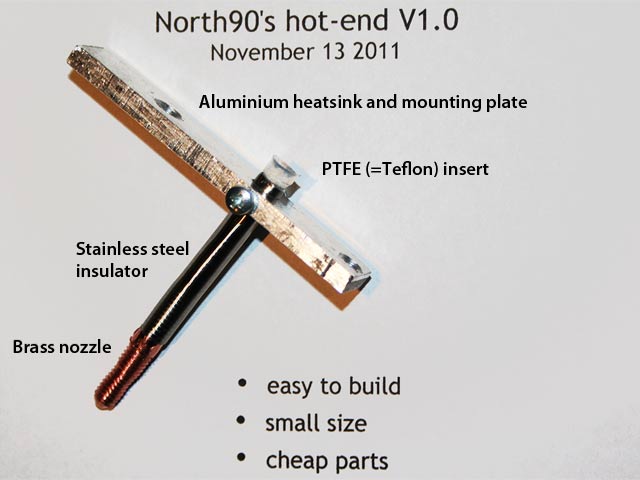North90's hot-end
This hot-end is designed to be build with simple tools and without the need for great engineering skills.
About the design
WHY another design? The complexity of most hot-end designs (lathe needed) and the use of hard to obtain and expensive materials (Peek) make it hard for the average person to build their own hot-end. This design is great for everyone who wants to build a hot-end but who doesn't have access to a lathe, cnc-machine and drill-press.
Thermal design
Each hot-end consists out of three main parts:
- hot end where the plastic is melting (usually brass tube + nozzle)
- insulator which keeps the heat away from the extruder (usually PTFE(=Teflon) rod)
- cold end the cool part of the hot-end which mounts to the extruder (can be any kind of material)
This hot-end uses stainless steel as an insulator. Stainless steel conducts heat less easily than normal steel, brass or aluminum, but much better than PTFE.
| MATERIAL | THERMAL CONDUCTIVITY W/(M*K) | NOTES |
|---|---|---|
| PTFE | 0.25 | will deform when hot: can't be used as structural part |
| PEEK | ~0.25 | expensive+hard to obtain |
| normal steel | 45 | |
| stainless steel | 18 | |
| brass | 120 | |
| aluminium | 220 | |
| dry wood | 0.05-0.12 |
from http://en.wikipedia.org/wiki/List_of_thermal_conductivities
The thermal conductivity of stainless steel is about a 100 times larger than that of PEEK or PTFE. To have a similar insulation as a PTFE insulator the cross-section of the insulator has to be a 100 times smaller.
A normal 16mm PTFE insulator (with a 3mm hole) has a cross-sectional surface area of 194mm2. The heat transfer for a PTFE insulator that is 25mm long at a temperature difference of 200C is 0.38W.
The stainless steel insulator of this hot-end is 6.35mm outside and an inside diameter of 5.7mm. The heat transfer for this insulator (25mm long and 200C) is about 1.1W. This is almost 3 times as high as the PTFE insulator of the same length.
The extra heat transferred through the stainless steel insulator has to be dissipated with a heat sink.
